A Project Roadmap: How to Keep a Team and Stakeholders on Track

Audio version:
Starting a project requires a piece of preparation that can be reflected on a detailed project roadmap. The bigger your activity is, the more thoroughly the planning process should be.
How to manage all the actions properly? How to allocate resources, keep track of time frames, milestones, and tasks? Finally, finish a project successfully, on time, so that team members and stakeholders will be satisfied?
A roadmap will help to cover all these needs at every stage of project realization. To learn more about project roadmaps and how to use this project management tool, read further our article.
Contents:
- What is a project roadmap?
- What does a project roadmap include?
- Why do you need a project roadmap?
- What’s the difference between a project roadmap and a project plan?
- Roadmap milestones.
- How to create a project roadmap?
- Benefits of a project roadmap.
- Challenges of a project roadmap.
- Project roadmap examples.
- Project roadmap templates.
- Roadmap tools.
- GanttPRO for project roadmaps.
- Conclusion.
What is a project roadmap?
A project roadmap is a graphical, high-level overview of objectives and main stages of the project. Usually, it is built on a timeline.
This popular project management tool enhances transparency, fosters stakeholder engagement, and supports informed decision-making. It is essential for maintaining focus and managing time effectively. That is why managers and teams from all over the world rely on it.
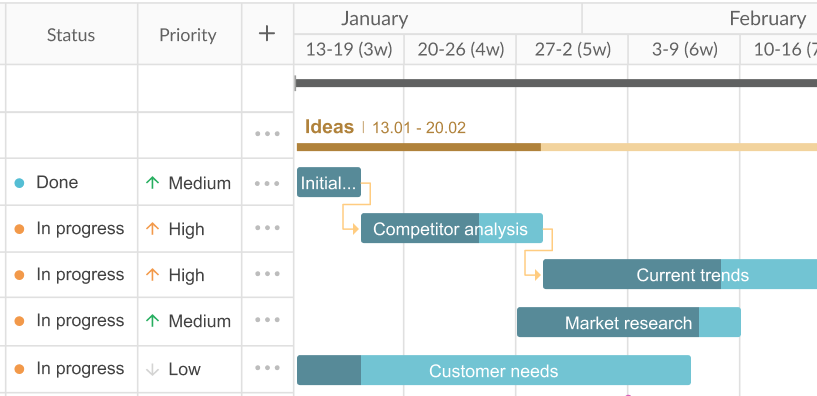
A project roadmap’s primary purpose is to ensure that everyone related to the project has a single truth source. This project management tool gives a clear and understandable vision of a project’s strategic goals and its implementation, including key tasks and milestones.
But it is always important to remember what a project roadmap is not.
For example, it is not a resource management tool. A project roadmap is not so focused on resource allocation; it is too in-depth for this project management tool. Your roadmap can only contain the main contacts for feedback from stakeholders.
Also, a project roadmap is not the same as a product roadmap. A product roadmap is more detailed and contains information about specific product development.
Sometimes a project roadmap is taken for a project management tracker. But it is not correct. A tracker is often used to maintain a project schedule. A project roadmap, in turn, provides an approximate timing of a project that can be changed during its implementation.
Finally, do not confuse a project roadmap with a project plan. A project roadmap is a project’s bird’s-eye vision without getting into trivial details. It is a simple and useful tool that helps keep stakeholders updated, manage their expectations, inform them about workflow progress, and communicate with other teams.
More about the differences between project roadmaps and project plans you will find in this article below.
What does a project roadmap include?
A project roadmap contains these critical elements:
- Project scope. In other words, it is a big picture of a plan, its goals, and what your team seeks to achieve at the project’s completion.
- Deliverables. It is a result of the work you have done during the project implementation. It can be anything: software, a document, or a physical product.
- A high-level project schedule and a timeline. It represents crucial activities your team needs to finish in chronological order during a particular time frame for successful project completion.
- Potential risks. Risks are bottlenecks or challenges during the project implementation that can cause budget, schedule, or workload deviation.
- Key milestones. These are events that illustrate a change of a project’s stage.
- Main contacts. It is a project representative’s contacts with whom stakeholders can communicate to clarify details, ask questions, or leave feedback.
Why do you need a project roadmap?
Project managers create roadmaps for a better understanding and clear vision of project implementation and its key objectives. This important PM tool keeps everyone aligned and informs about the workflow processes and scope.
Here’s how Heather Couture, a consultant and writer from North Carolina, US, evaluates the role of a project roadmap for her work:
When I work with clients on a new project, the roadmap is the first step. It clarifies the scope of work for the rest of the project. It decreases the uncertainty on what will need to be implemented. It also reduces the likelihood of going in circles or wasting time on unsuccessful approaches.
In essence, a roadmap is constant access to the plan’s progress where stakeholders and other teams can find actual information about its completion stage.
Five reasons to use a roadmap:
- To launch a project properly. A good launch of your project is necessary. It helps avoid uncertainty, missed deadlines, budget holes and ensure everyone does their work. Team members won’t feel stuck, and stakeholders won’t lose their interest.
- To ensure everyone is on top of project goals. More than 30% of companies say that miscommunication about project objectives is the number one reason why projects fail. Isn’t it impressive? Using roadmaps allows stakeholders to stay focused on business objectives even if they have changed during the project realization.
- To meet stakeholder expectations. According to a KPMG survey (2017), only one from three businesses carry out projects that get stakeholder approval. Using project roadmaps always keeps partners and third parties informed about critical tasks implementation, deadlines, milestones, and progress.
- To separate a work team from stakeholders. With a roadmap’s bird’s-eye view, you can prevent interferences in your team’s daily workflow and make the realization process more efficient and convenient. On the other hand, stakeholders are updated and focused on the high-level roadmap.
- To create the basis for a project plan. As we said earlier, a project plan is a more detailed and thorough visualization of a project realization. When stakeholders accept a roadmap, it is easy to expand it into a daily implementation plan.
What is the difference between a project roadmap and a project plan?
Now, when you know everything about roadmaps, we will tell you more about the difference between a roadmap and a project plan.
A project plan develops from a project roadmap. In other words, it is a more detailed description of every project stage, which is separated by milestones on the roadmap.
A project plan contains information about:
- All tasks and subtasks that need to be completed.
- Assignees.
- Project progress.
- Start and end date of every task and the whole project.
- Workload.
- Critical path.
- Additional required resources.
- Budgets and costs.
- Dependencies, milestones,
- and others.
One can visualize a plan on a timeline, Kanban board, or task list. A project roadmap is usually displayed on a Gantt chart.
However, it’s also worth remembering about the essence of this chart.
Here’s how Mike Clayton, the author of Online PM courses defines the difference between a Gantt chart and a roadmap.
A Gantt chart typically works at the level of tasks with rolled up summaries if you only want an overview. Its purpose is to visualize all the detailed activities that need to happen when they need to happen.
Roadmaps on the other hand work on the level of full functionality deliverables and significant outcomes. They offer a high level strategic view which avoids the detail of day-to-day tasks.
Since the plan contains more information about the project and its team, it will take you more time to create it. And, obviously, the project plan is much larger than the roadmap.
These are the most vivid differences of the pair “roadmap vs. project plan”, however, you can reveal more.
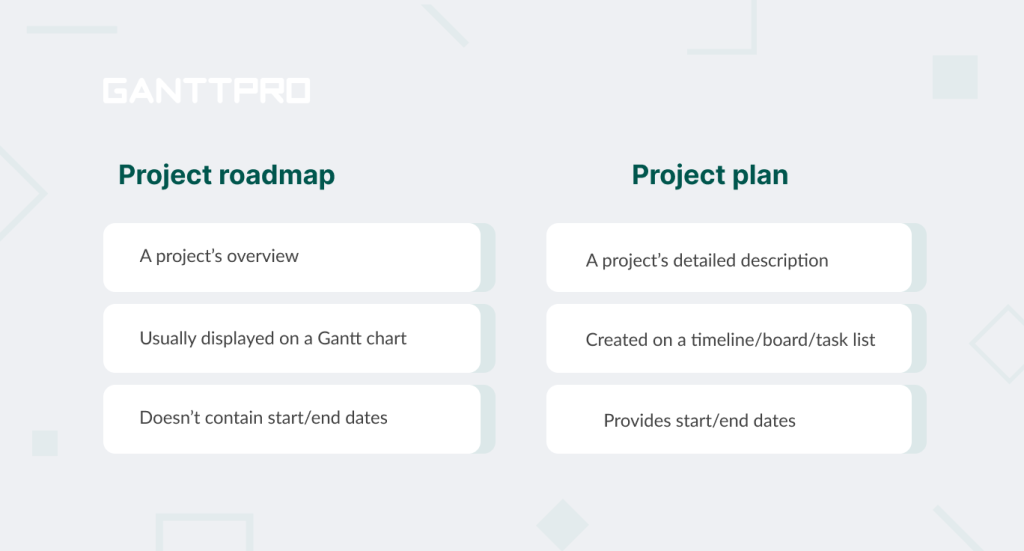
Roadmap milestones
A roadmap and a milestone is also an important topic we should mention here.
A typical roadmap milestone is a sign signaling an event or deadline that a manager wants the team to be aware of.
Any roadmap with milestones may include a release date or a date that the team needs to keep in mind as they work on the project. You can break up project phases by critical events, and milestones will help you mark all project life cycle stages.
Here is the list of some common project milestones examples:
- Early-stage milestones (project approval, planning, funding, etc.).
- Mid-project milestones (requirements review, completing critical tasks, reaching KPIs, etc.).
- Final stages milestones (testing stages, defects fixing, final approval, etc.).
Look at how a roadmap with a project milestone may look like.
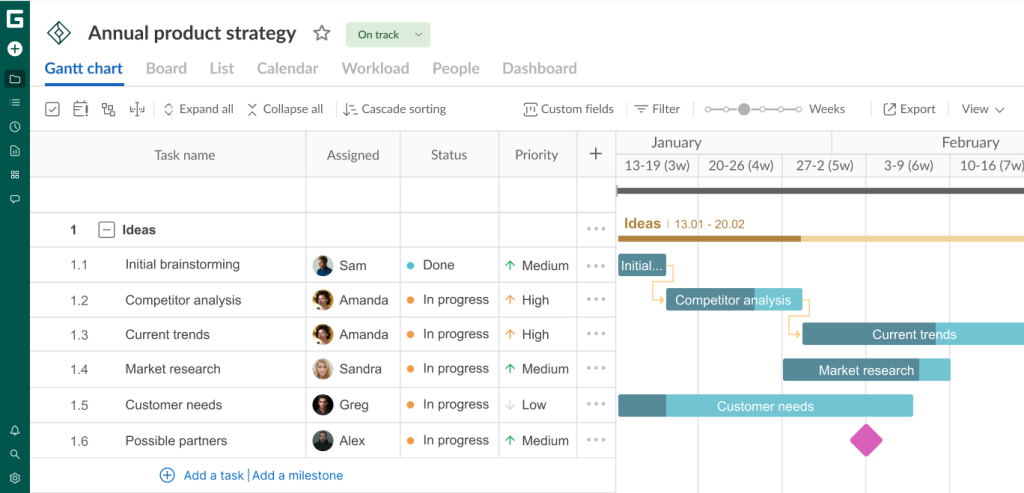
How to create a project roadmap?
Now it’s time to clarify how to create a project roadmap that will lead your project to success.
There is no standard scheme, universal template, or program for creating a roadmap. Its appearance and content depend on many factors:
- Professional area of your company.
- A project’s complexity and scale.
- A methodology your team uses to create project roadmaps.
- For whom the roadmap is going to be created (managers, investors, developers, or stakeholders).
Three necessary steps for a project roadmap creation:
1. Сollect all the information you need to start the project
The first step of creating a roadmap for a project relates to gathering all necessary information. You should collect it before creating a roadmap for a smoother project launch. Key objectives, project stages and milestones, possible risks, dependencies, and others — these all will help you to create a high-quality roadmap.
2. Hold a general meeting with the team and stakeholders
The purpose of such an event is to introduce a team to stakeholders, outline the expectations of stakeholders, and discuss all inaccuracies and gaps before starting the project.
3. Create a roadmap timeline with key milestones in it
It is possible by using templates, spreadsheets, or special software.
Voila, your visual project overview is ready and now you know that there in nothing extraordinary in creating a project roadmap.
Benefits of a project roadmap
An effective project roadmap provides the following benefits:
- Always keeps everyone on the same page. It helps all stakeholders to understand the scope of work, estimated timeframes, and key objectives.
- Manages stakeholder expectations. It separates non-negotiable and main project aspects from flexible ones.
- Shows task priorities. When new changes and circumstances appear, you can always refer to a roadmap and find the most important objectives agreed upon earlier. It helps to make quick decisions and properly prioritize tasks.
- Enables collaboration with other teams and departments. A strong roadmap allows sharing the document with anyone related to the project and communicating with other teams, taking part in project realization.
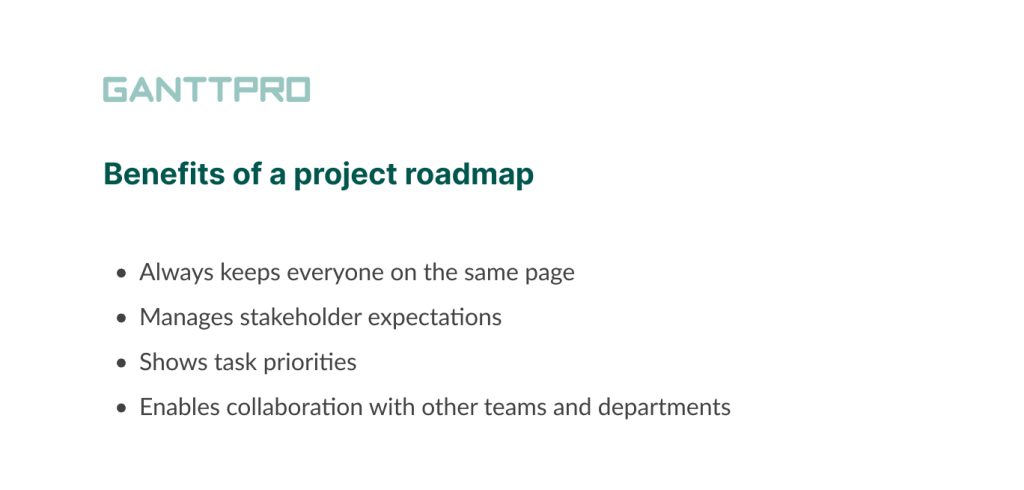
Challenges of a project roadmap
Despite its pros, there are some pitfalls while using roadmaps.
- Inaccurate time estimating. Many teams can have problems with time estimating. It causes budget overruns, project delays, or mismatched and inappropriate expectations.
- Difficulties with a roadmap updating. Things can go tough if you forget to update a roadmap or, on the contrary, update it too often. In the first scenario, the project will be behind schedule. The second can cause a loss of trust in management and its ability to make strategic and long-term plans.
- Neglect of sharing a roadmap with others. Even if third parties don’t directly participate in project implementation, they can impact it somehow. So it is better not to forget about the rest of the organization.
- Excessive detailing. Be careful with project details, otherwise a roadmap can be complicated to understand at first sight. Again, it is better to remember that a roadmap is only a project overview, it is a big picture.
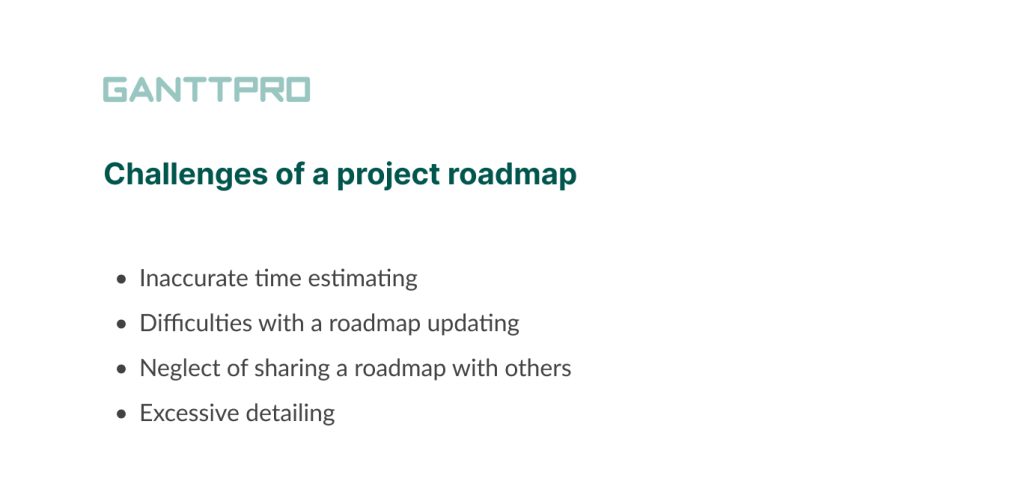
Roadmap examples
Each roadmap has its own characteristics, depending on the team and the company that is interested in its creation. Here’re some examples:
- A roadmap for developers is focused on features, sprints, milestones, and releases. It is typically short in duration and more granular in scope.
- A roadmap for sales teams focuses on the combination of features and customer benefits.
- An external roadmap (for partners and clients) is focused on the core benefits of a project. As any external document, it should be visually attractive and clear for understanding.
Best roadmap examples can save you from uncertainty and chaos because they represent all the plans and initiatives in an organized manner. They accomplish the vision and business mission in a visual way.
You may find many free or paid project roadmap examples, depending on a particular sphere or industry.
A typical project roadmap summarizes the core features and deliverables of your project, providing an overview of all strategic steps and the description of how, when, and who will complete these steps.
Here’s the example of a project roadmap that demonstrates the process of developing a corporate blog:
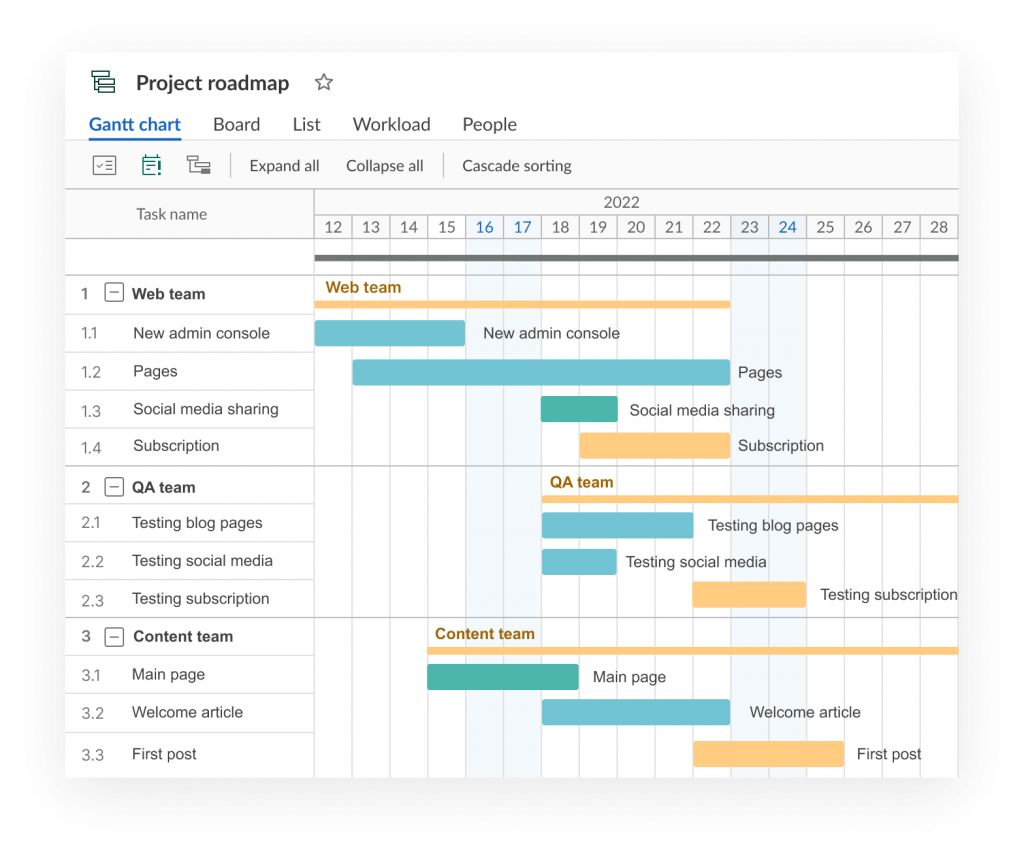
There is no ideal way to build a project roadmap, so you can use any example or a template to display your data, including:
Project roadmap templates
You can create roadmaps in basic programs such as Excel or PowerPoint. However, the designed documents are static, which causes difficulties in working with roadmaps in the future.
As we already know, roadmaps sometimes get supplemented, corrected, and updated. So, it will be quite difficult for you to redo the spreadsheet or presentation every time and send the document to the project participants over and over again.
Also, there are a lot of ready-made free project roadmaps templates available online. You can choose and download one and start using it straight away.
But there are a couple of bottlenecks while working with project roadmap templates:
- It is difficult to add extra project stages and details.
- Teamwork with such roadmaps is complicated without almost constant communication.
- Making quick changes is not so intuitive or easy and, as a result, are not really quick.
Roadmap tools
If your project is complex or expensive (or maybe, both), try out roadmap planning tools.
A roadmap tool is digital software that helps managers create a project overall view in various professional spheres.
It keeps all team members and other project participants aligned, ensures everyone has the same business goals, and provides robust communication processes among different departments and third parties.
Moreover, roadmapping software:
- Makes workflow more understandable and transparent.
- Helps track progress.
- Doesn’t demand constant manual document updating.
- Immediately notifies project participants about changes.
- Helps avoid cost overruns.
- Helps hit deadlines.
- Boosts team efficiency.
GanttPRO for project roadmaps
To facilitate the workflow, try out the software for creating a roadmap that completely suits you and your team. There are a lot of project management tools on the market that supply such a feature.
For example, take a look at GanttPRO — project management software that provides efficient and convenient workflow, from simple task management to robust project roadmap and project portfolio management.
Its intuitive and friendly interface will help you build a roadmap that will be understandable to every project participant and all stakeholders. The software allows you to create dependencies and milestones, manage budgets and timeframes, track progress and workload.
For a smooth team and stakeholders collaboration and effective workflow, GanttPRO provides the following features:
- Instant online notifications.
- Ability to leave comments, mention team members, attach files.
- Capability to undo actions and view the history of changes.
- Export Gantt charts to popular formats (PDF, PNG, and Excel).
- Working with MPP files.
- Resource allocation.
- Sharing public URL (both static and dynamic) even with unregistered users.
- Creating a critical path and baseline,
- and many others.
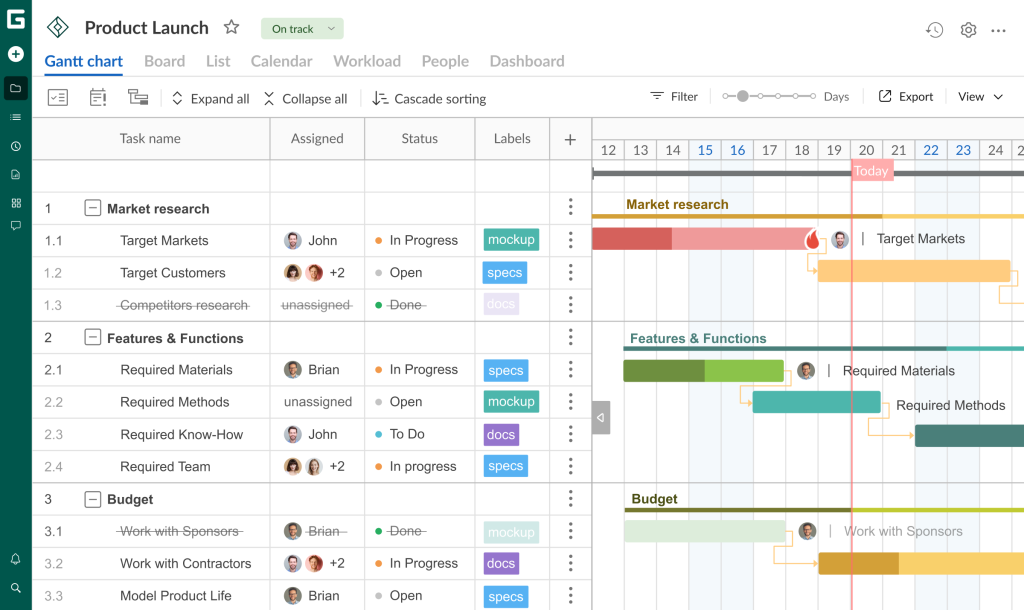
Incidentally, if you don’t clearly feel the difference between a roadmap and a bar diagram, it’s worth diving into the “Gantt chart vs. roadmap” comparison and learning the details.
Get a clear overview of your work processes with a robust project roadmap
A project roadmap is a PM tool that provides a visual overview of the project to everyone related to it. With its help, participants know everything about the project’s key objectives, deliveries, terms, and milestones.
But do not mess it with a project plan. Remember that a strong roadmap is a big picture of your project without details.
Proper utilization of this tool guarantees synchronization of your team, project stakeholders, and third parties. Everyone will be updated and on the same page. Finally, the right chosen project management software will facilitate the workflow and make it more transparent and efficient.
Frequently asked questions about a project roadmap
-
A roadmap in project management is a high-level plan that outlines the vision, direction, priorities, and progress of a project over time. It serves as a strategic guide for stakeholders, illustrating major milestones, deliverables, and timelines to ensure alignment and clarity on project objectives and phases.
-
A typical project roadmap includes the project’s goals, key milestones, and timelines, outlining the major phases and deliverables. It provides a high-level overview of the project’s objectives, critical tasks, and dependencies. The roadmap also helps align stakeholders by communicating the project’s progress and ensuring everyone is aware of important deadlines and events.
-
The purpose of a typical roadmap is to provide a high-level overview of a project’s goals, milestones, and timelines, ensuring alignment among stakeholders. It helps track progress, manage expectations, and facilitate communication about key deadlines and events.
-
A Gantt chart is not a roadmap. The chart is a type of bar diagram that represents a project schedule, showing the start and finish dates of tasks or the entire project. In contrast, a roadmap outlines a strategic plan and high-level goals of a project or product, focusing on the vision, milestones, and long-term objectives. While both are planning tools, a Gantt chart is more detailed and time-specific, whereas a roadmap is broader and more strategic. Project managers often use a Gantt chart to create a roadmap, as it perfectly visualizes all project details and shows a top-level work plan.
-
A roadmap provides a high-level overview of goals, milestones, and strategic direction, focusing on long-term objectives and major phases. In contrast, a project schedule details the specific tasks, timelines, and resources required to complete each aspect of a project. It also emphasizes short-term activities and deadlines. Essentially, a roadmap outlines the “what” and “why,” while a project schedule addresses the “how” and “when.”
-
A roadmap is a strategic document outlining high-level goals, key milestones, and the overall vision for a project or product over time, providing direction and long-term perspective. A plan, however, is a detailed document that specifies the steps, actions, resources, and timelines needed to achieve the goals outlined in the roadmap.
-
Stakeholders and team members should review a project roadmap regularly, typically every quarter. It allows them to ensure alignment with evolving goals and market conditions. However, reviews may be more frequent if a project is highly dynamic or undergoing significant changes.
Read also
Join 1M+ project managers!
Create Gantt charts in minutes with GanttPRO and reduce time spent on managing tasks by 40%
Try for freeNo credit cards required. No obligation.
